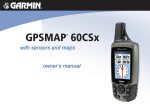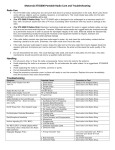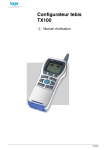Download GVRC - Artisan Technology Group
Transcript
Artisan Technology Group is your source for quality new and certified-used/pre-owned equipment • FAST SHIPPING AND DELIVERY • TENS OF THOUSANDS OF IN-STOCK ITEMS • EQUIPMENT DEMOS • HUNDREDS OF MANUFACTURERS SUPPORTED • LEASING/MONTHLY RENTALS • ITAR CERTIFIED SECURE ASSET SOLUTIONS SERVICE CENTER REPAIRS Experienced engineers and technicians on staff at our full-service, in-house repair center WE BUY USED EQUIPMENT Sell your excess, underutilized, and idle used equipment We also offer credit for buy-backs and trade-ins www.artisantg.com/WeBuyEquipment InstraView REMOTE INSPECTION LOOKING FOR MORE INFORMATION? Visit us on the web at www.artisantg.com for more information on price quotations, drivers, technical specifications, manuals, and documentation SM Remotely inspect equipment before purchasing with our interactive website at www.instraview.com Contact us: (888) 88-SOURCE | [email protected] | www.artisantg.com Force 11 GLOBAL POSITIONING SYSTEM (GPS) VERSA MODULE EUROPA (VME) RECEIVER CARD (GVRC) Installation, Operation, and Maintenance Manual April 1, 1997 Part Number 30300-00 Rev C. TRIMBLE NAVIGATION, LTD. Sunnyvale, CA 94086 Artisan Technology Group - Quality Instrumentation ... Guaranteed | (888) 88-SOURCE | www.artisantg.com GPS VME Receiver Card (GVRC) Table of Contents 1.0 1.1 1.2 1.3 Introduction................................................................................................................................... 1 Purpose............................................................................................................................................ 1 Capabilities ..................................................................................................................................... 1 1.2.1 Overview ............................................................................................................................ 1 1.2.2 Position, Velocity, and Time (PVT) GPS Solutions........................................................... 1 1.2.3 External Interfaces.............................................................................................................. 2 1.2.4 Dynamics ............................................................................................................................ 2 1.2.5 Environment ....................................................................................................................... 2 Characteristics................................................................................................................................. 2 1.3.1 GPS Signals ........................................................................................................................ 2 1.3.2 Accuracy............................................................................................................................. 2 1.3.3 Satellite Acquisition and Selection ..................................................................................... 3 1.3.3.1 Signal Acquisition Process..................................................................................... 3 1.3.3.2 Time-to-First-Fix (TTFF)....................................................................................... 3 1.3.3.3 Satellite Selection................................................................................................... 4 1.3.4 Anti-Spoofing (A-S) ........................................................................................................... 4 1.3.4.1 Anti-Spoofing ON and Anti-Spoofing OFF ........................................................... 5 1.3.4.2 Anti-Spoofing Operation........................................................................................ 5 1.3.4.3 Anti-Spoofing OFF Operation................................................................................ 5 1.3.4.4 Summary of Primary Operating Modes ................................................................. 6 1.3.5 Selective Availability (SA) ................................................................................................. 6 1.3.5.1 General................................................................................................................... 6 1.3.5.2 GVRC SA .............................................................................................................. 7 1.3.6 GVRC Initialization Using PLGR ...................................................................................... 7 2.0 2.1 Installation ..................................................................................................................................... 8 Installation Configuration................................................................................................................ 8 2.1.1 Set VME Address ............................................................................................................... 8 2.1.2 Select Controlling Interface ................................................................................................ 12 2.1.3 Configure Antenna Bias...................................................................................................... 12 2.1.4 Configure RF Input Attenuation ......................................................................................... 12 2.1.5 Pre-Set Jumper and Switch Configuration.......................................................................... 13 2.1.6 Instrumentation Port (IP) Baud Rate Selection................................................................... 13 2.2 Controls, Indicators and Connectors ............................................................................................... 14 2.2.1 Front-Panel Control and Indicators ................................................................................................. 14 2.2.2 Interface Connectors ....................................................................................................................... 14 2.3 GVRC Interface Cabling................................................................................................................. 15 3.0 3.1 3.2 Maintenance and Service.............................................................................................................. 16 Troubleshooting .............................................................................................................................. 16 3.1.1 Power.................................................................................................................................. 16 3.1.2 Signal.................................................................................................................................. 16 3.1.3 Built-in Test Protocols........................................................................................................ 16 3.1.3.1 Initial Self-Test ...................................................................................................... 17 3.1.3.2 Commanded BIT.................................................................................................... 17 3.1.3.3 Background BIT..................................................................................................... 17 Software Upgrades .......................................................................................................................... 18 Page ii Trimble Navigation P/N 30300-00, Rev. C Artisan Technology Group - Quality Instrumentation ... Guaranteed | (888) 88-SOURCE | www.artisantg.com Installation, Operation & Maintenance Manual 4.0 4.1 4.2 Testing............................................................................................................................................ 19 RS-232 and RS-422 Interface ......................................................................................................... 19 VMEbus Interface ........................................................................................................................... 19 Appendix A Glossary ............................................................................................................................. A-1 April 1, 1997 Trimble Navigation Artisan Technology Group - Quality Instrumentation ... Guaranteed | (888) 88-SOURCE | www.artisantg.com Page iii GPS VME Receiver Card (GVRC) Tables Table No. Page No. 1-1 1-2 1-3 GVRC Dynamic Limits............................................................................................................ 2 Accuracy .................................................................................................................................. 3 FOM and Definition................................................................................................................. 4 2-1 2-2 2-3 2-4 2-5 2-6 S100 Switches and VME Address Relationships ..................................................................... 8 Configure Controlling Interface ............................................................................................... 12 Configure Antenna Bias Voltage ............................................................................................. 12 Pre-Set Jumper and Switch Configuration ............................................................................... 13 LED Indications ....................................................................................................................... 14 GVRC Interface Connectors .................................................................................................... 15 Figures Figure No. 2-1 2-2 2-3 Page iv Page No. GVRC Connectors and Pin Arrangement................................................................................. 9 GVRC Pin-to-Signal Assignments ........................................................................................... 10 GVRC Jumper and DIP Switch Locations ............................................................................... 11 Trimble Navigation P/N 30300-00, Rev. C Artisan Technology Group - Quality Instrumentation ... Guaranteed | (888) 88-SOURCE | www.artisantg.com Installation, Operation & Maintenance Manual 1. INTRODUCTION 1.1 Purpose The GPS Versa Module Europa (VME) Receiver Card (GVRC) is a Precise Positioning Service (PPS) receiver designed to collect and process the Global Positioning System (GPS) satellite signals to derive accurate 3-dimensional position, velocity, and time. The receiver can also be aided by an auxiliary sensor for increased performance in integrated applications. 1.2 Capabilities 1.2.1 Overview The GVRC operates with signals broadcast from the NAVSTAR Global Positioning System satellites. As the satellites orbit the earth, the satellite availability changes continuously. The GVRC contains functions for determining the availability of satellites at any given time, and for determining the optimum times for usage. When the GVRC is operated with antenna line-of-sight visibility to the sky, the GVRC automatically searches for satellite signals and acquires the data necessary for a GPS solution. Using data derived from satellite signals, the GVRC calculates position, velocity, and time (PVT) solutions for output via the digital data ports. The GVRC is capable of operating in a Precise Positioning Service (PPS) mode after an authorized operator has loaded the appropriate cryptovariables. Cryptovariables (CVs) can be entered through the key fill port by using a KOI-18, KYK-13, or AN/CYZ-10 data loader. CVs can also be manually entered via the digital data ports. Operation in the PPS mode mitigates the effects of Selective Availability (SA), and the Anti-Spoofing (A-S) feature allows access to the encrypted Ycode. The GVRC is capable of processing both the P(Y)-code and C/A-code on the L1/L2 GPS frequencies. When not authorized for PPS operation, the GVRC is capable of operating in the Standard Positioning Service (SPS) mode. Hardware and software zeroize functions allow cryptovariable information and all volatile memory data to be immediately and irreversibly deleted from GVRC memory components. The remainder of this section briefly outlines the various capabilities of the GVRC. 1.2.2 Position, Velocity, and Time (PVT) GPS Solutions The GVRC calculates position, velocity and time solutions at a maximum rate of one solution per second. The accuracy of the solution depends on the operating mode and other conditions as described in section 1.3.2. Each solution is time-tag referenced to GPS and/or Universal Coordinated Time (UTC). The GVRC provides Precise Time and Time Interval (PTTI) data in several formats. Time rollover pulses are provided at each UTC second and minute. Binary Coded Decimal (BCD) timeof-day data is also provided in accordance with ICD-GPS-156 and ICD-GPS-060. HaveQuickcompliant time-of-day signals are provided in Manchester code. April 1, 1997 Trimble Navigation Artisan Technology Group - Quality Instrumentation ... Guaranteed | (888) 88-SOURCE | www.artisantg.com Page 1 GPS VME Receiver Card (GVRC) 1.2.3 External Interfaces The GVRC is designed to be installed in a VMEbus system. The antenna interface is a SMA connector to support a coaxial cable connection to a remote antenna. The GVRC incorporates three distinct input/output interfaces. The primary control, power, and data interface is the VMEbus which complies with the IEEE STD-1014-1987 VMEbus Specification and ICD-GPS-156. An Instrumentation Port (IP) which complies with ICD-GPS-150 is provided on the GVRC face plate (see figure 2-1). The IP is an RS-232 communications port incorporating a DB9 style connector. The third interface option is the Maintenance Port (MP) which is also implemented as an RS-232 port on the face plate, and is configured for the Precision Lightweight GPS Receiver (PLGR) interface standard mode (see section 1.3.6). The KOI-18/KYK-13/CYZ-10 interface is a single function port for insertion of encryption keys. The key loading port complies with ICD-GPS-225 and CZE-93-105. Proper use of the key loading port is required for PPS operation. This interface also includes a discrete to zeroize CVs. 1.2.4 Dynamics The GVRC is capable of providing outputs with the specified accuracy throughout the dynamic environment expected for naval vessels and water craft. The default velocity, acceleration, and jerk limits are summarized in Table 1-1. Table 1-1. GVRC Dynamic Limits Characteristic Velocity Acceleration Jerk Limit 40 m/s 15 m/s/s 7.5 m/s/s/s 1.2.5 Environment The GVRC will operate to specified performance levels at temperatures from 0o C to +60o C. It can be stored at temperatures from –40o C to +85o C with no degradation. The GVRC is designed to operate in conditions of relative humidity up to 98 percent including condensation in the form of water and frost. The GVRC satisfies EMI/C requirements of MIL-STD-461C (Class A1a), and is resistant to jamming and spoofing when properly keyed. 1.3 Characteristics 1.3.1 GPS Signals The GVRC operates on the L1/L2 GPS frequencies and has the capability to demodulate both the C/A-code and the P(Y)-code. When an authorized user has keyed the GVRC with the appropriate cryptovariables, the GVRC can remove SA accuracy degradation and operate with the encrypted Y-code. 1.3.2 Accuracy Table 1-2 compares PPS enabled GVRC performance with SPS accuracy. Table 1-2. Accuracy Page 2 Trimble Navigation P/N 30300-00, Rev. C Artisan Technology Group - Quality Instrumentation ... Guaranteed | (888) 88-SOURCE | www.artisantg.com Installation, Operation & Maintenance Manual Scenario Accuracy POSITION ACCURACY (Authorized User) 16 meters SEP (steady state) 18 meters SEP (maximum dynamics) POSITION ACCURACY (Unauthorized User) 76 meters SEP VELOCITY ACCURACY (Authorized User) 0.1 meter/sec RMS (no jerk, unaided) 0.03 meters/sec RMS (aided) PULSE-PER-SECOND TIMING ACCURACY 100 nanoseconds (1 sigma) HAVE QUICK TIMING ACCURACY 10 microseconds (1 sigma) The listed position accuracies are in terms of meters, spherical error probable (SEP). The listed accuracies apply assuming a user range error (URE) (Space/Control) of less than 4.0 meters under the following conditions: a. Position Dilution of Precision (PDOP) less than 2.57 b. Horizontal Dilution of Precision (HDOP) less than 1.6 c. Vertical Dilution of Precision (VDOP) of less than 2.0 d. Unmodelled ionospheric error of less than 5 meters (one sigma) SPS Mode (unauthorized user) values assume that Selective Availability is active. The GVRC computes a Figure of Merit (FOM) value which equates to an Expected Position Error (EPE) as shown in Table 1-3. 1.3.3 Satellite Acquisition and Selection 1.3.3.1 Signal Acquisition Process When power is applied, the GVRC enters the INITIALIZATION mode in which it does not attempt to acquire and track satellites. Upon being commanded to the NAVIGATION mode, the GVRC uses information stored in memory to determine which satellites are above the horizon and the approximate Doppler frequencies of the signals. Typically, this information would include the satellite constellation almanac, the last GVRC position fix, and an estimate of current time. If any of this information is not resident in GVRC memory when power is applied, the time to acquisition will be lengthened unless the user provides this initialization data to the unit. Position and time estimates, plus almanac information can be inputted through any one of the digital data ports. 1.3.3.2 Time-to-First-Fix (TTFF) Time-to-first fix is the elapsed time from the user demand on the GVRC to the first display of accurate PVT data. The probability is 0.95 that the TTFF will be less than 90 seconds, provided the GVRC position uncertainty does not exceed 100 km, the GVRC has a time uncertainty of less than 2 minutes, current almanac is available, and the cryptovariables for that day are loaded and validated (if SA/A-S operation is required). April 1, 1997 Trimble Navigation Artisan Technology Group - Quality Instrumentation ... Guaranteed | (888) 88-SOURCE | www.artisantg.com Page 3 GPS VME Receiver Card (GVRC) Table 1-3. FOM and Definition 1.3.3.3 FOM Expected Position Error (EPE) 1 less than or equal to 25 2 greater than 25, less than or equal to 50 3 greater than 50, less than or equal to 75 4 greater than 75, less than or equal to 100 5 greater than 100, less than or equal to 200 6 greater than 200, less than or equal to 500 7 greater than 500, less than or equal to 1000 8 greater than 1000, less than or equal to 5000 9 greater than 5000 (in meters) Satellite Selection The GVRC will consider all satellite vehicles (SVs) currently being tracked for use in calculating a GPS solution. The satellites must satisfy line-of-sight masking criteria (minimum signal level, minimum elevation angle, maximum GDOP, and the 4SV/3SV switch GDOP) to be used in calculating a solution. The GVRC will track the eight highest satellites in view and calculate a PVT solution. The GVRC will automatically select fewer satellites if eight are not available. If four satellites are not available or there is no four-satellite combination which provides GDOP lower than the GDOP switch mask, the GVRC will augment available satellites with external sensor data when available. In this condition, the GVRC will use altitude hold (when enabled), employing the last known GPS altitude, or a value input from the host system. As time passes and the satellite availability changes, the GVRC will automatically acquire rising satellites and adjust the selected constellation for the solution. 1.3.4 Anti-Spoofing (A-S) The GVRC can provide the navigation accuracy presented in section 1.3.2 in a spoofing environment. A spoofing environment is considered to be present when at least one deceptive pseudolite signal is being received which has the same C/A- and P-codes associated with a valid Pseudo Random Noise (PRN) code number. Deceptive signals are typically broadcast at signal levels of up to 10 dB greater than received satellite signal levels. The deceptive signal attempts to force the GPS receiver to calculate erroneous PVT data by shifting to the higher power pseudolite carrier and code Doppler rates away from the actual satellite carrier and code Doppler rates. The GVRC can protect against deception and denial of GPS service. Protection is provided during initial satellite signal acquisition, satellite signal re-acquisition during normal operation, and while incorporating a new satellite into the PVT solution set. Rejection of the deception signals is based on use of the encrypted Y-code. Page 4 Trimble Navigation P/N 30300-00, Rev. C Artisan Technology Group - Quality Instrumentation ... Guaranteed | (888) 88-SOURCE | www.artisantg.com Installation, Operation & Maintenance Manual 1.3.4.1 Anti-Spoofing ON and Anti-Spoofing OFF The GVRC operates in either an ANTI-SPOOFING ON or an ANTI-SPOOFING OFF condition. In the ON condition, it is optimized for use against spoofers. While in the OFF condition, it is optimized for ease of use and improved TTFF. When powered on, the GVRC defaults to the ANTI-SPOOFING ON condition. If the database is complete and the GVRC is keyed, the GVRC will proceed to acquire and track satellites in this mode when commanded to NAVIGATE by the user. 1.3.4.2 Anti-Spoofing Operation The GVRC must be correctly initialized to enable ANTI-SPOOFING ON operation. If not resident within the GVRC memory, user insertion of initialization data via any of the available data ports must include the following data: a. Current SV almanac b. Current position; accurate within 100 km c. Current time; accurate within two (2) minutes d. Valid cryptovariables If the initialization data is not available, the GVRC will remain in the WAITING FOR INITIALIZATION state when commanded to the NAVIGATION mode. Otherwise it will commence search and acquisition of satellites. 1.3.4.3 Anti-Spoofing OFF Operation If operational conditions permit, or if initialization data insertion cannot be completed, the GVRC can be operated in the ANTI-SPOOF OFF (mixed mode) condition. The following types of operation are possible with ANTI-SPOOFING OFF: a. PPS receiver operation (tracking P-code corrected for SA), b. C/A-code differential GPS operation (keyed or unkeyed) and connected via any of the digital data ports to a source of differential corrections, c. SPS receiver operation using C/A-code, d. Blind search (no knowledge of initial position, time, or satellite visibility), e. “Anywhere” searches (poor or unreliable knowledge of position, but having approximate time and almanac). In the ANTI-SPOOFING OFF mode, the GVRC will, upon being commanded to NAVIGATION, search for and acquire satellites regardless of the initial status of its database. To prevent inadvertent corruption of a database in a spoofing environment, GVRC always powers on in the ANTI-SPOOFING ON condition (unless exiting from a power-interrupt condition of less than 30 seconds). The GVRC must be deliberately switched to ANTI-SPOOFING OFF before it will attempt to acquire satellites when not fully initialized. The GVRC database may be initialized from an external source while in INITIALIZE mode. 1.3.4.4 Summary of Primary Operating Modes INITIALIZE. The GVRC does not attempt to search, acquire or track satellites. The GVRC defaults to this mode following power-up or reset. An exception is following a short (less than 30 April 1, 1997 Trimble Navigation Artisan Technology Group - Quality Instrumentation ... Guaranteed | (888) 88-SOURCE | www.artisantg.com Page 5 GPS VME Receiver Card (GVRC) second) power interruption, in which case the GVRC returns to the mode present prior to interruption. The GVRC must be in this mode to accept the following initialization data: a. Time of day b. Initial position c. Almanac d. Ephemeris e. Lever arms f. L1/L2 equipment delay The GVRC will accept aiding data in the INITIALIZE mode. NAVIGATE. In this mode the GVRC searches for, acquires, and tracks satellites to calculate a navigation solution. It accepts aiding data and utilizes a blending filter to calibrate system accuracy. In the Y-CODE ONLY mode, the GVRC will remain in the INITIALIZE mode after being commanded to NAVIGATE, unless it has initial position, time, almanac, and cryptovariables, as discussed in section 1.3.4.3. Once this data is supplied, the GVRC will transition to NAVIGATE mode if it was formerly commanded to do so. TEST Mode. The GVRC enters this mode to perform commanded or initial built-in-test. STANDBY Mode. This is similar to INITIALIZE mode with the exception that the GVRC will attempt Y-code re-acquisition after having been in this mode for a period of up to 20 minutes, upon being commanded back to NAVIGATE. 1.3.5 Selective Availability (SA) 1.3.5.1 General In the early days of GPS, the DoD directed that GPS include the capability to deny military utility to unauthorized users. Selective Availability and Anti-Spoofing (SA and A-S) are the results of that directive. SA is the deliberate introduction of errors into the GPS measurements. This denial of accuracy is implemented in two ways. First, predetermined errors are introduced into the navigation data transmitted by the satellites. The result is that unauthorized users (users without receivers that can neutralize the error) compute erroneous positions and clock offsets. Second, the satellite clock itself is altered. Whereas errors in the navigation data create slowly varying errors in the position solutions, the clock dither produces a much faster error behavior. Clock dither is quite obvious in velocity computations. SA results in errors in position, velocity, and time. With SA off, and without differentially correcting the data, horizontal accuracy using single-frequency code-phase receivers has been demonstrated to be about 12 meters Circular Error Probable (CEP) (30 meters 95% of the time). With SA in effect, the U.S. government promised 40 meters horizontally CPE , and less than 173 meters 95% of the time. 1.3.5.2 GVRC Selective Availability and Key Loading When operating with current cryptovariables loaded, GVRC automatically removes SA error. Cryptovariables are loaded into the GVRC using the front panel J10 connector. While the keyloading device is attached and operated, the GVRC front panel ORANGE LED blinks at a rate Page 6 Trimble Navigation P/N 30300-00, Rev. C Artisan Technology Group - Quality Instrumentation ... Guaranteed | (888) 88-SOURCE | www.artisantg.com Installation, Operation & Maintenance Manual of 2.5 Hz. When the keyloader is removed or inactivated, the ORANGE LED blinks at 1 Hz until keys are validated, whereupon the ORANGE LED is continuously illuminated. Once CVs have been loaded, the user has the option to specify a mission duration to the GVRC. This is a period, in days, after which the GVRC security module will automatically zeroize the CVs. Once CVs are loaded, the mission duration defaults to one (1) day. The user may modify the value once, and only once, as follows: Step 1: Enter a mission duration via one of the digital interfaces within one (1) hour of the loading of the CVs. Maximum value is 244 days. Step 2: Operate the GVRC through or during a period of greater than one (1) hour, but less than one (1) day, following loading of the CVs. In this case the GVRC will set a default mission duration of 240 days. If the user does not perform either of Step 1 or Step 2 above, the GVRC will zeroize CVs upon subsequent power-up (default of one day exceeded). Note in the above that the period of one (1) day commences at midnight (UTC) on the day in which CVs were loaded. Once set, mission duration cannot be reset prior to expiration without first zeroizing the keys and re-keying. 1.3.6 GVRC Initialization Using PLGR The maintenance port defaults to the PLGR interface standard mode (9600 baud, 8 data bits, no parity and 1 stop bit) regardless of jumper settings. This port can be connected to a PLGR which can be commanded to transfer initialization data to the GVRC. Refer to the PLGR operating manual for details. Once a transfer is commenced, GVRC will enter the INITIALIZATION mode. Following successful transfer, the GVRC will enter the STANDBY mode. April 1, 1997 Trimble Navigation Artisan Technology Group - Quality Instrumentation ... Guaranteed | (888) 88-SOURCE | www.artisantg.com Page 7 GPS VME Receiver Card (GVRC) 2. INSTALLATION 2.1 Installation Configuration Figure 2-1 illustrates the GVRC board connectors and general configuration. Figure 2-2 presents the pin-to-signal assignments (pin-outs) for the VME connectors and the face-plate connectors. Figure 2-3 identifies the locations of the various DIP switches and jumpers that can be set to provide the desired configuration for the GVRC. The pre-set configuration installed at the factory prior to delivery is defined in section 2.1.5. The GVRC requires the following operator settings before installation into a double-height, singlewidth slot of a VMEbus rack: • Set the VME address (refer to section 2.1.1) • Select the controlling interface (refer to section 2.1.2) • If required, select the 5-VDC bias for the GPS antenna and low-noise amplifier (LNA) (refer to section 2.1.3) • Configure proper RF input attenuation (refer to section 2.1.4) 2.1.1 Set VME Address The GVRC must be configured to interface on the VME bus. Setting the individual DIP switches of S100 establishes the address of the GVRC. Figure 2-3 depicts the location of switch S100. Data or instructions passed over the VME bus to or from the GVRC are coded with a unique device address. The device address determined by the settings of S100 must match the address used by the VME bus controller. At initial installation the GVRC S100 switches should be set to the values required by the bus-controller software. Table 2-1 identifies the VME address bit for each of the 10 switches of S100. Turn a switch on to assert its address line, and turn the switch off to negate the address line. Table 2-1. S100 Switches and VME Address Relationships Page 8 Switch # VME Address Bit # Switch # VME Address Bit # 10 23 5 18 9 22 4 17 8 21 3 16 7 20 2 15 6 19 1 Not used Trimble Navigation P/N 30300-00, Rev. C Artisan Technology Group - Quality Instrumentation ... Guaranteed | (888) 88-SOURCE | www.artisantg.com Installation, Operation & Maintenance Manual J11 J9 J10 J5 J6 J7 J4 J100 J151 J150 P1 PIN B1 P2 PIN A1 Figure 2-1. GVRC Connectors and Pin Arrangement April 1, 1997 Trimble Navigation Artisan Technology Group - Quality Instrumentation ... Guaranteed | (888) 88-SOURCE | www.artisantg.com Page 9 GPS VME Receiver Card (GVRC) Pin # Signal Name Pin # Signal Name Pin # Signal Name VME P1 CONNECTOR A1 A2 A3 A4 A5 A6 A7 A8 A9 A10 A11 A12 A13 A14 A15 A16 A17 A18 A19 A20 A21 A22 A23 A24 A25 A26 A27 A28 A29 A30 A31 A32 D00 D01 D02 D03 D04 D05 D06 D07 GND SYSCLK GND DS1 DS0 WRITE GND DTACK GND AS GND ACK ACKIN ACKOUT AM4 A07 A06 A05 A04 A03 A02 A01 –12V +5V B1 B2 B3 B4 B5 B6 B7 B8 B9 B10 B11 B12 B13 B14 B15 B16 B17 B18 B19 B20 B21 B22 B23 B24 B25 B26 B27 B28 B29 B30 B31 B32 BBSY BCLR ACFAIL BGO IN BGO OUT BG1 IN BG1 OUT BG2 IN BG2 OUT BG3 IN BG3 OUT BR0 BR1 BR2 BR3 AM0 AM1 AM2 AM3 GND SERCLK SERDAT GND IRQ7 IRQ6 IRQ5 IRQ4 IRQ3 IRQ2 IRQ1 +5VSTDBY +5V C1 C2 C3 C4 C5 C6 C7 C8 C9 C10 C11 C12 C13 C14 C15 C16 C17 C18 C19 C20 C21 C22 C23 C24 C25 C26 C27 C28 C29 C30 C31 C32 D08 D09 D10 D11 D12 D13 D14 D15 GND SYSFAIL BERR SYSRESET LWORD AM5 A23 A22 A21 A20 A19 A18 A17 A16 A15 A14 A13 A12 A11 A10 A09 A08 +12V +5V VME P2 CONNECTOR A1 A2 A3 A4 A5 A6 A7 A8 A9 A10 A11 A12 A13 A14 A15 A16 A17 A18 A19 A20 A21 A22 A23 A24 A25 A26 A27 A28 A29 A30 A31 A32 TM CODE IN + TM FAULT IN (ACTIVE LOW) TM FAULT IN A TM CODE OUT A TM FAULT OUT (ACTIVE LOW) TM FAULT OUT A HAVEQUICK OUT RS-422 OUT A RS-422 IN A TIME MARK PULSE BAUD RATE SELECT D RESET GVRC RDY NC NC NC NC NC NC NC NC NC NC NC NC NC NC NC NC NC NC NC J9 CONNECTOR (IP) 1 2 3 4 5 6 7 8 9 N/C RS-232 TX RS-232 RX N/C GND PPS IN N/C N/C N/C B1 B2 +5V GND C1 C2 TM CODE IN – TBD B3 B4 B5 RESERVED A24 A25 C3 C4 C5 TM FAULT IN B TM CODE OUT B TBD B6 B7 B8 B9 B10 B11 B12 B13 B14 B15 B16 B17 B18 B19 B20 B21 B22 B23 B24 B25 B26 B27 B28 B29 B30 B31 B32 A26 A27 A28 A29 A30 A31 GND +5V D16 D17 D18 D19 D20 D21 D22 D23 GND D24 D25 D26 D27 D28 D29 D30 D31 GND +5V J11 CONNECTOR (MP) 1 2 3 4 5 6 7 8 9 N/C RS-232 TX RS-232 RX N/C GND PPS IN N/C N/C N/C C6 C7 C8 C9 C10 C11 C12 C13 C14 C15 C16 C17 C18 C19 C20 C21 C22 C23 C24 C25 C26 C27 C28 C29 C30 C31 C32 TM FAULT OUT B HAVEQUICK OUT RTN RS-422 OUT B RS-422 IN B NC NC NC NC NC NC NC NC NC NC NC NC NC NC NC NC NC NC NC NC NC NC NC J10 CONNECTOR (KEYFILL) 1 2 3 4 5 6 7 8 9 SA/AS RETURN N/C KYK E KYK C KYK A ZEROIZE -- ALL LOAD STATUS KYK D KYK B Figure 2-2. GVRC Pin-to-Signal Assignments (Pin-outs) Page 10 Trimble Navigation P/N 30300-00, Rev. C Artisan Technology Group - Quality Instrumentation ... Guaranteed | (888) 88-SOURCE | www.artisantg.com Installation, Operation & Maintenance Manual J151 J150 RF Attenuation Jumpers 5 VDC Antenna Bias Jumper Controlling Interface Select Jumper VME Address Switch S100 Figure 2-3. GVRC Jumper and DIP Switch Locations April 1, 1997 Trimble Navigation Artisan Technology Group - Quality Instrumentation ... Guaranteed | (888) 88-SOURCE | www.artisantg.com Page 11 GPS VME Receiver Card (GVRC) 2.1.2 Select Controlling Interface The GVRC can be configured to have either the VME interface or the Instrument Port as the controlling interface, as specified in ICD-GPS-156. Select the desired controlling interface as indicated in Table 2-2. Note that only commands described in ICD-GPS-156 are influenced by this setting. The Interface Control jumper is located on the jumper block labeled J150 as shown in Figure 2-3. Table 2-2. Configure Controlling Interface Controlling Interface Jumper Instrument port Inserted VME interface Removed 2.1.3 Configure Antenna Bias Voltage The GVRC can be configured to have a 5-VDC bias voltage on the center pin of the RF input connector by inserting a jumper where indicated in Figure 2-3. The antenna bias voltage jumper is located on jumper block J150. Table 2-3. Configure Antenna Bias Voltage Bias Voltage Status Jumper +5 VDC Present Inserted No Bias Voltage Removed 2.1.4 Configure RF Input Attenuation The GVRC can be configured with jumpers to attenuate the RF input. Proper installation of the jumper(s) is required for optimal performance. Too much attenuation of the RF input can cause low or inconsistent SNR readings when tracking satellites. Too little attenuation of the RF input can cause degraded anti-jamming performance. The GVRC has six jumper settings ranging from 1 dB to 32 dB which will allow the RF input to be attenuated from 1 dB up to 63 dB. See Figure 2-3 for the location of the six jumpers on the GVRC. The attenuation jumpers are located on jumper block J151 (2, 4, 8, 16, and 32 dB) and block J150 (1 dB). The jumpers provide a range of attenuation to account for installation-dependent variations in the antenna LNA and signal losses in the RF cable connecting the LNA to the GVRC. Page 12 Trimble Navigation P/N 30300-00, Rev. C Artisan Technology Group - Quality Instrumentation ... Guaranteed | (888) 88-SOURCE | www.artisantg.com Installation, Operation & Maintenance Manual The configuration of the jumper(s) is dependent on the LNA that provides amplification to the satellite signals received at the antenna and the signal loss due to the RF cable connecting the LNA to the GVRC. The initial attenuation setting is calculated by taking the base value of –21 dB, adding the gain of the LNA, and then subtracting the loss of the RF cable. (The base value of –21 dB is the difference between the P(Y)-code signal level of –163 dB at the antenna (as specified in ICD-GPS-200), and the minimum required signal level of –142 dB at the RF input of the GVRC (as specified in CI-GVRC-300).) Examples: Pre-amplifier Gain minus Cable Loss Recommended Attenuation Setting 21 dB 0 dB 35 dB 14 dB (8 + 4 + 2) 50 dB 29 dB (16 + 8 + 4 + 1) 2.1.5 Pre-Set Jumper and Switch Configuration The pre-set configuration of the GVRC upon delivery from the manufacturer is presented in Table 2-4. Table 2-4. Pre-Set Jumper and Switch Configuration VME Address Bits S100 All Switches OFF (All Bits Negated) Controlling Interface J150 Jumper Not Installed (VME Interface Controls) Antenna Bias Voltage J150 Jumper Not Installed (No Bias Voltage) RF Attenuation Factory Testing Options J151 and J150 Jumper Installed on J151 at the 8 dB position. Other positions have no jumpers installed J100 The Jumpers on block J100 are not for user-selectable options. No jumpers installed for operational service. 2.1.6 Instrumentation Port (IP) Baud Rate Selection The GVRC can be commanded into either of two instrumentation port (IP) baud rates. The standard rate is 9600 baud which is compatible with the PLGR standard. The high data rate is 19,200 baud for receive and 76,800 baud for transmit. The IP baud rate is selectable by the user via the A11 pin on connector P2. If the A11 pin is connected to chassis ground, the IP operates in April 1, 1997 Trimble Navigation Artisan Technology Group - Quality Instrumentation ... Guaranteed | (888) 88-SOURCE | www.artisantg.com Page 13 GPS VME Receiver Card (GVRC) the high data rate mode. If the A11 pin is not connected (open circuit), the IP operates in the PLGR standard data rate. 2.2 Controls, Indicators and Connectors In addition to the configuration switches and jumpers, the GVRC provides controls and indicators on its front panel that can be used during operation. Six connectors (four on the front panel, two on the plug-in edge) provide convenient interface with various system functions. 2.2.1 Front-Panel Control and Indicators The RESET switch on the front panel causes a reset when operated, and the receiver is reset to the INITIALIZE mode. Host equipment will need to re-initialize the VME interface and re-establish IP/MP connectivity following activation of this reset. Refer to ICD-GPS-156 for further details. There are four LED indicators on the front panel of the GVRC. Collectively, they indicate the current status of the GVRC, as shown in Table 2-5. Table 2-5. LED Indications LED PWR (red) OPNL (yellow) FIX (green) KEYS (orange) Yellow, green, and orange Condition Indicates Constantly lit Power is applied to GVRC Constantly lit GVRC is operational Blinking Fatal error detected by boot program (e.g., corrupted/invalid main program) Constantly lit Position fix in process Constantly lit Keys are valid Rapidly blinking Key loader is detected Slowly blinking Keys accepted but not yet verified Blinking in unison Built-in test (BIT) in process 2.2.2 Interface Connectors The GVRC interface connectors are listed in Table 2-6. Page 14 Trimble Navigation P/N 30300-00, Rev. C Artisan Technology Group - Quality Instrumentation ... Guaranteed | (888) 88-SOURCE | www.artisantg.com Installation, Operation & Maintenance Manual Table 2-6. GVRC Interface Connectors Interface Connector Location VMEbus VME P1 Back edge ICD-GPS-150/156 (using RS-422) VME P2 Back edge PTTI timing signals (per ICD-GPS-060) VME P2 Back edge L1/L2 RF signals J4 SMA (RF IN) and 50-ohm cable Front panel ICD-GPS-150/156 (using RS-232) DB9 J9 IP (Instrument Port) J11 MP (Maintenance Port) Front panel KOI-18/KYK-13/ANCYZ-10 keyfill DB9 J10 (KEYFILL) Front panel Pulse-Per-Second Out BNC J6 (PPS OUT) Front panel Pulse Per Minute Out BNC J7 (PPM OUT) Front panel Pulse Per Second In BNC J5 (PPS IN) Front panel . 2.3 GVRC Interface Cabling Standard off-the-shelf commercial cables can be used to interface the RS-232 digital data ports to an IBM-compatible PC. April 1, 1997 Trimble Navigation Artisan Technology Group - Quality Instrumentation ... Guaranteed | (888) 88-SOURCE | www.artisantg.com Page 15 3. GPS VME Receiver Card (GVRC) MAINTENANCE AND SERVICE The GVRC is designed to require very little operator maintenance or service. It has a built-in test (BIT) capability for self-diagnostic check of operations. 3.1 Troubleshooting The GVRC is designed with a BIT feature that performs a power-up self test. The self test can detect 95% of all failures. If a significant failure has occurred, which is indicated by the orange LED on the front panel, status can by obtained via any one of the digital data ports. None of the BIT failures can be repaired by the operator. Repair of the GVRC is completed above the organizational level. Refer to approved maintenance instructions for disposition of retrograde units. 3.1.1 Power The GVRC indicates power is present by a lighted red LED on the front panel. • If the GVRC fails to power-up, verify that proper external input power is supplied to the GVRC. • If it is determined that proper power is supplied to the GVRC, the unit must be returned for repair. 3.1.2 Signal If the GVRC will not track satellites, be sure that the antenna is free from obstruction and has an unrestricted view of the sky. If tracking does not begin within a reasonable time, zeroizing the GVRC will clear all memory and return the unit to default settings. CAUTION EMERGENCY ZEROIZE is to be used with caution. All GVRC random access memory, including position, cryptovariables, almanac, time, and ephemeris data will be erased if this method of zeroize is used. Memory data lost during EMERGENCY ZEROIZE may be manually restored through one of the digital data ports. 3.1.3 Built-In Test Protocols The GVRC performs three types of built-in test (BIT). On initial application of power, the GVRC completes a self-test and reports a GO or NO GO status to the NAVSSI host. The GVRC will respond to a host command to complete a self-test at any time during normal operation. The Page 16 Trimble Navigation P/N 30300-00, Rev. C Artisan Technology Group - Quality Instrumentation ... Guaranteed | (888) 88-SOURCE | www.artisantg.com Installation, Operation & Maintenance Manual GVRC also performs a background BIT during normal operation as a method of performance monitoring. The GO and NO GO status discrete is a dedicated pin on the VME P2 connector. The commanded and background BIT results are provided via shared memory in the O-GVRC21 output message which is defined in ICD-GPS-156. As a means of maintenance support, or whenever implemented by the NAVSSI host, the GVRC provides extended status and health communications over the IP or MP via the serial communications ports on the front panel or VME P2 connector. The IP/MP status and health communications are defined in the TIPY protocol ICD (P/N 27028-01). 3.1.3.1 Initial Self-Test The POWER ON SELF-TEST is initiated on first application of power to the GVRC or in response to a system reset command. The reset can be implemented in any of three ways. The reset toggle switch on the front panel may be placed momentarily to RESET. The Discrete Reset (DRESET) signal may be asserted on pin A12 of VME connector P2. The reset may also be commanded by software from the NAVSSI host. When the self-test is in progress, the GVRC stops all processing and indicates “not ready” or NO GO by outputting a logic 0 (less than 0.6 VDC) on pin A13 of VME connector P2. Upon successful completion of the self-test (less than 8 seconds), the GVRC enters the INITIALIZATION mode and asserts “ready” or GO on pin A13 of VME connector P2. 3.1.3.2 Commanded BIT The results of the commanded BIT are reported in shared memory output message 0-GVRC21 Word 9, Initial/Commanded BIT Log. The Word 9 log provides status on 8 receiver functions as follows: EEPROM/RAM/A-D Converter/DPRAM Auxiliary Power Low or Absent Security Module Reference Clock Low Power Time Source A-D Converter BIT Channel BIT Task Status Further definition of the faults identified in Word 9 is provided in Words 11 through 19 of message 0-GVRC21. 3.1.3.3 Background BIT The results of the performance monitoring tests (background BIT) are reported to the NAVSSI host in message 0-GVRC21 Word 8. The faults which can be reported in Word 8 are as follows: AGC Level Low Security Module Fault Auxiliary Power Low ICD-225 CV Erase Fault L2 Tracking Fault Software Zeroize Failed Hardware Zeroize Failed Shorted Antenna Fault Open Antenna Fault High Antenna Current April 1, 1997 Trimble Navigation Artisan Technology Group - Quality Instrumentation ... Guaranteed | (888) 88-SOURCE | www.artisantg.com Page 17 GPS VME Receiver Card (GVRC) Clock Reference Fault Task/OS Fault Further definition of the faults identified in Word 8 is provided in Words 11 through 19 of message 0-GVRC21. 3.2 Software Upgrades Software upgrades will be made available, as necessary, to update the operational program, the MAGVAR table, and the Datum tables in the GVRC. These upgrades will be IBM PC compatible and can be downloaded via the RS-232 or RS-422 data ports. MAGVAR and Datum Tables which are stored in read-only memory (ROM) are individually field upgradeable. PC-based software is used to re-program the ROM. Refer to approved maintenance instructions. The GVRC employs dual sets of MAGVAR and datum information. One set is part of the main program, and the second is the field loaded file. The GVRC will test for a field-loaded file and will then select for use either its internal or the down-loaded data depending on which has the later date code. Software version numbers and date code information for the active MAGVAR and Datum information is stored within the Card ID area of the GVRC shared memory. Refer to ICD-GPS-156 for details. Page 18 Trimble Navigation P/N 30300-00, Rev. C Artisan Technology Group - Quality Instrumentation ... Guaranteed | (888) 88-SOURCE | www.artisantg.com Installation, Operation & Maintenance Manual 4. TESTING 4.1 RS-232 and RS-422 Interface Application software is provided to run on an IBM-compatible personal computer to allow a PC operator to fully test the GVRC. The program includes: 4.2 FLASH.EXE Reads the current software image file and downloads into the GVRC. Also used for MAGVAR and Datum upgrades. TPMON.EXE Monitor program to exercise the GVRC via the TIPY digital data port. DATAMON.EXE Monitor program to exercise the GVRC via the ICD-GPS153 digital data port. Note that if the PC operator has the GVRC transmitting data at 76.8K Baud, the PC must have a special serial I/O board. VMEbus Interface Testing of the VMEbus interface requires a special diagnostic analyzer installed in the VMEbus rack which is interfaced to an IBM-compatible personal computer. April 1, 1997 Trimble Navigation Artisan Technology Group - Quality Instrumentation ... Guaranteed | (888) 88-SOURCE | www.artisantg.com Page 19 Artisan Technology Group - Quality Instrumentation ... Guaranteed | (888) 88-SOURCE | www.artisantg.com Glossary Appendix A GLOSSARY Acronyms and Abbreviations ELA ELD EMC EMI EMP EPE EPLRS 2D 2dRMS 3D Two Dimensional RMS error Three Dimensional ALM A-S AVG AZ Almanac Anti-Spoofing Average Azimuth BCD BIT Binary Coded Decimal Built-In Test C CA CEP CMD CR CRS CV CVW Celsius Climb Angle Circular Error Probable Command Climb Rate Course Cryptovariable Crypto Variable Weekly DA DAE dB/Hz dBW deg desel dm DMA dms DoD DOP DPORT DTM Department of the Army Departure Angle Error Decibels per Hertz Decibels referenced to 1 Watt Degrees Deselect Degrees, Decimal Minutes Defense Mapping Agency Degrees, Minutes, Seconds Department of Defense Dilution of Precision Data Port Datum E EAE ECEF ECM ECCM EFM EHE EIA EIR EL East Entry Angle Error Earth-Centered Earth-Fixed Electronic Counter Measures Electronic Counter-Counter Measures Ephemeris Estimated Horizontal Error Electronic Industries Association Equipment Improvement Report Elevation April 1, 1997 ETA EVE Elevation Angle Elevation Distance Electromagnetic Compatibility Electromagnetic Interference Electromagnetic Pulse Estimated Position Error Enhanced Position Location Reporting System Estimated Time of Arrival Estimated Verticle Error F fix FOM FRZ ft ft/sec Fahrenheit Position Fix Figure of Merit Freeze Foot Foot Per Second GDOP G GPA GPE GPS GPU GS GUV GVAR GVRC HPA Geometric Dilution of Precision Grid Glide Path Angle Glide Path Error Global Positioning System General Purpose User Ground Speed Group Unique Variable Grid Variation Global Positioning System (GPS) Versa Module Europa (VME) Receiver Card Helmet Antenna Height Above Ellipsoid High Altitude, High Opening Heading Horizontal Dilution of Precision High Mobility Muti-purpose Wheeled Vehicle Horizontal Position Accuracy IAW ICD IM INIT I/O In Accordance With Interface Control Document Installation Mount Initialize Input/Output HA HAE HAHO HDG HDOP HMMWV Trimble Navigation Artisan Technology Group - Quality Instrumentation ... Guaranteed | (888) 88-SOURCE | www.artisantg.com A-1 GPS VME Receiver Card (GVRC) JTIDS Joint Tactical Information Distribution System km km/h kts L lat LCD lcl L/L LLA lon LRU Kilometer Kilometers Per Hour Knots Local Time Latitude Liquid Crystal Display Local Latitude/Longitude Latitude/Longitude/Altitude Longitude Line Replaceable Unit M m MK m/s m/s/s MAG MAGVAR MCSP MGRS MI MIL Magnetic North Meter Mark Meters per second Meters per second per second Magnetic Magnetic Variation Mission Complete Success Probability Military Grid Reference System Statute Miles Angualr Measure for 1/6400th of a Circle Minimum Miss Distance Miles Per Hour Mean Sea Level Magnetic Variation Manpack/Vehicle MMD MPH MSL mvar M/V N N/A NAV NBC NM NTISSI O&M OPA OPS P PDOP POS posfix PP pps PPS PPS-SM PRN PTTI A-2 PVT Position, Velocity & Time RA RAM REAC RNG ROM Remote Antenna Random Access Memory Reaction Time Range Read Only Memory S SA SA/A-S SEP SM sq SR SS SSI STBY STR STR-3D STS SV(s) South Selective Availability Selective Availability/ Anti-Spoofing Spares Acquisition Integrated with Production Spherical Error Probable Security Module Square Slant Range System Specification Systems Security Instruction Standby Steering Angle Up/Down Steering Angle Status Satellite Vehicles(s) T TFOM TGT TM TNG TR TRK TTFF TTG TTSF True Time Figure of Merit Target Technical Manual Training Technical Report Track Time To First Fix Time To Go Time To Subsequent Fix UPS URA URE USRA UTC UTM Universal Polar Stereo-graphic User Range Accuracy User Range Error User-Supplied Remote Antenna Universal Time, Coordinated Universal Transverse Mercator VA VDOP VEL VEP Vehicle Antenna Vertical Dilution of Precision Velocity Vertical Error Probable SAIP North Not Applicable Navigation Nuclear, Biological & Chemical Nautical Mile National Telecommunications & Information Operations & Maintenance Overall Position Accuracy Operations Page Position Dilution of Precision Position Position Fix Present Position Pulse Per Second Precise Positioning Service Precise Positioning Service-Security Module PseudoRandom Noise Precise Time & Time Interval Trimble Navigation April 1, 1997 Artisan Technology Group - Quality Instrumentation ... Guaranteed | (888) 88-SOURCE | www.artisantg.com Glossary W WGS WMM WP West World Grid System World Magnetic Model Waypoint XTE Crosstrack Error YD Yards Z Zulu Time Glossary Of Terms 2dRMS Twice the distance root mean squared. As used by the operators of the GPS when specifying SA levels, it is the error distance within which 95% of the position solutions will fall. 2D Two-dimensional positions. A 2D position fix provides latitude and longitude. Elevation is assumed to be fixed. Only three satellites are required to provide a 2D position with a user-supplied elevation. 3D 3D position provides the elevation in addition to Lat/Lon and requires four satellites. Almanac A reduced-precision subset of the ephemeris parameters. Used by the GVRC to compute the elevation and azimuth angles of the satellites. Each satellite broadcasts the almanac for all the satellites. C/A-code Coarse/Acquisition code. This is the "civilian" code made available by the Department of Defense (DoD). It is subject to SA. The authorized user can correct the degradation effects of SA. Channel Refers to the GVRC hardware that is required to lock to a satellite, make the range measurements and collect data from the satellite. Cryptovariable The coded information transferred to the GVRC manually or via key loaders which allow the GVRC to begin SA correction and/or P(Y)-code demodulation. Differential Navigation A technique similar to relative positioning except that one or both of the points may be moving. The pilot of a ship or aircraft may need to know his position relative to a harbor or runway. A data link is used to relay the error terms to the moving vessel to allow realtime navigation. ENU A topocentric spherical coordinate system, "East-North-Up". Elevation Difference Vertical distance from current position to waypoint. Elevation Angle The angle between the line of sight vector and the horizontal plane. Elevation Mask Refers to the elevation angle below which a satellite is considered unusable. It is used to prevent the GVRC from searching for satellites which are obscured by buildings or mountains. Ephemeris A set of parameters that describe a satellite's orbit very accurately. It is used by the GVRC to compute the position of the satellite. This information is broadcast by the satellites. GDOP Geometric Dilution of Precision describes how much an uncertainty in range affects the uncertainty in position. It depends on where the satellites are relative to the user. Ground Speed Velocity over the ground. Geoid Actual physical shape of the earth which is difficult to describe mathematically because of the local surface irregularities and sea-land variations. GPD Global positioning with differential corrections applied. April 1, 1997 Trimble Navigation Artisan Technology Group - Quality Instrumentation ... Guaranteed | (888) 88-SOURCE | www.artisantg.com A-3 GPS VME Receiver Card (GVRC) GPS Time The length of the second is fixed and is determined by primary atomic frequency standards. Leap-seconds are not used as they are in Universal Time Coordinated. HDOP Horizontal Dilution of Precision describes how an uncertainty in range affects the horizontal position (latitude and longitude). IODE Issue Of Data, Ephemeris. Part of the navigation data. It is the issue number of the ephemeris information. A new ephemeris is available usually on the hour. L1 The primary L-band signal radiated by each NAVSTAR satellite at 1575.42 Mhz. The L1 beacon is modulated with the NAV message. L2 is centered at 1227.60 MHz. L2 The secondary L-band signal radiated by each NAVSTAR satellite at 1227.6 MHz. Key Loader Cryptokey loading device KYK-13, KOI-18, or AN/CYZ-10. Mapping Datum Refers to a mathematical model of the earth. Many local datums model the earth for a small region: e.g., Tokyo datum, Alaska, NAD-27 (North American). Others, WGS-84, for example, model the whole earth. NAV Data The 1500 bit navigation message broadcast by each satellite at 50 bps on both L1 and L2 beacons. This message contains system time, clock correction parameters, ionospheric delay model parameters, and the vehicle's ephemeris and health. This information is used to process GPS signals to obtain user position and velocity. P-code The "Precise" code sent on both L1 and L2 GPS beacons. When encrypted, it is resistant to SA and spoofing. Pseudo-random noise (PRN) Each GPS satellite generates its own distinctive PRN code which serves as identification of the satellite, as a timing signal, and as a subcarrier for the navigation data. Pseudorange A measure of the range from the GVRC's antenna to the satellite. Pseudo-range is obtained by multiplying the speed of light by the apparent transit time of the signal from the satellite. PDOP Position Dilution of Precision is the determination of position uncertainty in range affecting both the horizontal position (latitude and longitude) and the vertical position (elevation). Range Horizontal distance from current position to waypoint. Relative Positioning The process of determining the vector distance between two points and the coordinates of one spot relative to another. This technique yields GPS positions with greater precision than the single-point positioning mode. Rise/Set Time The period during which a satellite is visible; i.e., has an elevation angle that is above the elevation mask. A satellite is said to "Rise" when its elevation angle exceeds the mask and "Set" when the elevation drops below the mask. TDOP Time Dilution of Precision, the uncertainty of clock bias, affects the horizontal position (latitude and longitude). Time To Go Estimated time to go until arrival at a waypoint. VDOP Vertical Dilution of Precision describes how an uncertainty in range affects the vertical position (elevation). Velocity Three-dimensional velocity. A-4 Trimble Navigation April 1, 1997 Artisan Technology Group - Quality Instrumentation ... Guaranteed | (888) 88-SOURCE | www.artisantg.com Artisan Technology Group is your source for quality new and certified-used/pre-owned equipment • FAST SHIPPING AND DELIVERY • TENS OF THOUSANDS OF IN-STOCK ITEMS • EQUIPMENT DEMOS • HUNDREDS OF MANUFACTURERS SUPPORTED • LEASING/MONTHLY RENTALS • ITAR CERTIFIED SECURE ASSET SOLUTIONS SERVICE CENTER REPAIRS Experienced engineers and technicians on staff at our full-service, in-house repair center WE BUY USED EQUIPMENT Sell your excess, underutilized, and idle used equipment We also offer credit for buy-backs and trade-ins www.artisantg.com/WeBuyEquipment InstraView REMOTE INSPECTION LOOKING FOR MORE INFORMATION? Visit us on the web at www.artisantg.com for more information on price quotations, drivers, technical specifications, manuals, and documentation SM Remotely inspect equipment before purchasing with our interactive website at www.instraview.com Contact us: (888) 88-SOURCE | [email protected] | www.artisantg.com


















































